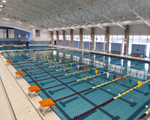On a beautiful autumn day a long time ago, I was on a glorious backpacking trip to Pictured Rocks National Lakeshore in Michigan’s Upper Peninsula. One still morning while rinsing off in Little Beaver Lake, I was alarmed to hear voices that sounded very near, as I was sporting my birthday suit. After quickly sinking into the water up to my neck, I searched for the people and to my relief found them on the opposite shore of the small lake, out of “detailed sight” range. That was a memorable lesson in how well water reflects sound.
Sound reflection off water is approximately the same as a finished concrete floor or terrazzo. Virtually all sound is reflected from these surfaces. This fact presents a serious reverberation concern in natatoriums, which tend to be all hard surfaces (in addition to the pool) to avoid moisture and mold issues in room finishes.
Contrary to the common assumption that not much can be done about the reverberation, sound absorbing treatments are indeed available for natatoriums. There are fiberglass panels which have been sealed from moisture permeation, and they help tremendously in reducing the reverberation time. Lower reverberation time increases speech intelligibility and reduces background sound levels, which not only make it easier for occupants to hear each other and for audiences to hear announcements, but can be the difference between life and death when a lifeguard needs to focus on where a scream of “Help!” is coming from. An improved acoustical environment through sound absorbing treatments will make the space more acoustically pleasing for occupants, and the reflections from the water’s surface won’t create as much stress as I once experienced.
At Acoustics By Design, we routinely design acoustical finishes for pools and natatoriums. Absorbing some of the unwanted reflections makes all the difference between an optimized aquatic space and a typical noisy pool space.
